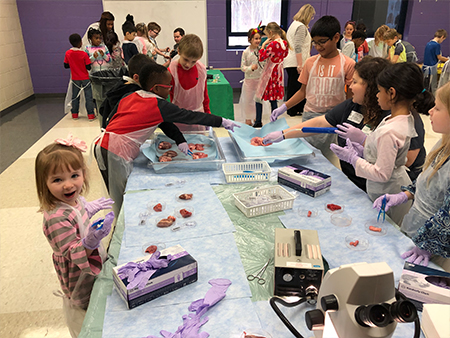Media contact: Alicia Rohan
 In a room filled with many “oohs” and “ahs,” and more than a few “eews,” second-graders listened to each other’s heartbeats, learned how long their intestines are, and felt pig hearts and lungs.
In a room filled with many “oohs” and “ahs,” and more than a few “eews,” second-graders listened to each other’s heartbeats, learned how long their intestines are, and felt pig hearts and lungs.
It is thanks to a program where science is brought to the classroom in fun, interactive ways started by a researcher at the University of Alabama at Birmingham.
Carmel McNicholas-Bevensee, Ph.D., associate professor in the Department of Cell, Developmental, and Integrative Biology, conducted her ninth annual CDIB Science Outreach Program, formerly known as PhUn (Physiology Understanding, American Physiological Society).
This year’s program, held at South Shades Crest Elementary School in Hoover, Alabama, focused on teaching students how to be responsible for their health by explaining the benefits of making healthy choices and showing them the lasting damage caused by unhealthy choices through several hands-on activities. McNicholas-Bevensee believes short, interactive activities are the most beneficial.
“This program leaves a lasting impact on students and leaves parents buzzing as well,” said LaRue Frederick, assistant principal at South Shades Crest Elementary School. “Students learn to relate what they learned to everyday activities. We have seniors who come back every year, walk through the halls and talk about how much they enjoyed this program.”
McNicholas-Bevensee is joined by UAB volunteers ranging from senior faculty to undergraduate students from across campus, in addition to parent volunteers.
Students learned about the functions of vital organs, how to build and maintain a healthy lifestyle, and how to perform self-assessments by rotating through five stations.
One station let the students feel pig organs, such as lungs and hearts. They were taught how to identify the different parts of each organ, and they had a chance to see the lungs inflate, as they would in their own bodies, with the use of a bike pump.
“Cool! Do my lungs do that, too?” said a 7-year-old girl as she watched the lungs inflate.
At another station, students used a lungometer where each student had a chance to test their vital lung capacity by measuring the amount of air they blew out of their lungs, teaching them how people differ in the amount of air they can expel from their lungs.
Students also learned how to use microscopes to look at tissue, experimented with anatomical models, and learned how to use stethoscopes, blood pressure monitors and pulse oximeters by practicing on themselves and others.
Once the stations were completed, McNicholas-Bevensee gave a presentation on healthy living, which emphasized the importance of nutrition, exercise, heart health and the dangers of tobacco.
McNicholas-Bevensee believes it is very important for youth to develop an interest in science and STEM education, and she is interested in expanding this program to other schools throughout the state. This year, four schools will participate, reaching approximately 1,000 students.
“I thoroughly enjoy working with children and want to spark their interests in science,” McNicholas-Bevensee said. “I loved science when I was a child, and I want to pass that on.”
Schools interested in this program should contact McNicholas-Bevensee at cbevense@uab.edu.